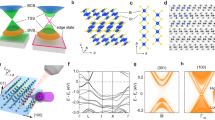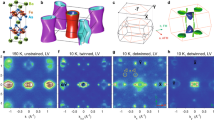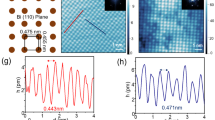Abstract
Crystalline symmetries have played a central role in the identification and understanding of quantum materials. Here we investigate whether an amorphous analogue of a well known three-dimensional strong topological insulator has topological properties in the solid state. We show that amorphous Bi2Se3 thin films host a number of two-dimensional surface conduction channels. Our angle-resolved photoemission spectroscopy data are consistent with a dispersive two-dimensional surface state that crosses the bulk gap. Spin-resolved photoemission spectroscopy shows this state has an anti-symmetric spin texture, confirming the existence of spin-momentum locked surface states. We discuss these experimental results in light of theoretical photoemission spectra obtained with an amorphous topological insulator tight-binding model, contrasting it with alternative explanations. The discovery of spin-momentum locked surface states in amorphous materials opens a new avenue to characterize amorphous matter, and triggers the search for an overlooked subset of quantum materials outside of current classification schemes.
This is a preview of subscription content, access via your institution
Access options
Access Nature and 54 other Nature Portfolio journals
Get Nature+, our best-value online-access subscription
$29.99 / 30 days
cancel any time
Subscribe to this journal
Receive 12 print issues and online access
$259.00 per year
only $21.58 per issue
Buy this article
- Purchase on Springer Link
- Instant access to full article PDF
Prices may be subject to local taxes which are calculated during checkout




Similar content being viewed by others
Data availability
All data needed to evaluate the conclusions in the paper are present in the paper and/or the Supplementary Information. Additional data related to this paper may be requested from the authors.
References
Vergniory, M. G. et al. A complete catalogue of high-quality topological materials. Nature 566, 480–485 (2019).
Watanabe, H., Po, H. C. & Vishwanath, A. Structure and topology of band structures in the 1651 magnetic space groups. Sci. Adv. 4, eaat8685 (2018).
Hasan, M. Z. & Kane, C. L. Colloquium: topological insulators. Rev. Mod. Phys. 82, 3045–3067 (2010).
Agarwala, A. & Shenoy, V. B. Topological insulators in amorphous systems. Phys. Rev. Lett. 118, 236402 (2017).
Mitchell, N. P., Nash, L. M., Hexner, D., Turner, A. M. & Irvine, W. T. M. Amorphous topological insulators constructed from random point sets. Nat. Phys. 14, 380–385 (2018).
Marsal, Q., Varjas, D. & Grushin, A. G. Topological Weaire–Thorpe models of amorphous matter. Proc. Natl Acad. Sci. USA 117, 30260–30265 (2020).
Spring, H., Akhmerov, A. R. & Varjas, D. Amorphous topological phases protected by continuous rotation symmetry. SciPost Phys. 11, 22 (2021).
Zhang, H. et al. Topological insulators in Bi2Se3, Bi2Te3 and Sb2Te3 with a single Dirac cone on the surface. Nat. Phys. 5, 438–442 (2009).
Treacy, M. M. J., Gibson, J. M., Fan, L., Paterson, D. J. & McNulty, I. Fluctuation microscopy: a probe of medium range order. Rep. Prog. Phys. 68, 2899–2944 (2005).
Voyles, P. & Muller, D. Fluctuation microscopy in the stem. Ultramicroscopy 93, 147–159 (2002).
Lucovsky, G., Mooradian, A., Taylor, W., Wright, G. & Keezer, R. Identification of the fundamental vibrational modes of trigonal, α-monoclinic and amorphous selenium. Solid State Commun. 5, 113–117 (1967).
Zhang, J. et al. Raman spectroscopy of few-quintuple layer topological insulator Bi2Se3 nanoplatelets. Nano Lett. 11, 2407–2414 (2011).
Kim, Y. S. et al. Thickness-dependent bulk properties and weak antilocalization effect in topological insulator Bi2Se3. Phys. Rev. B 84, 073109 (2011).
Analytis, J. G. et al. Two-dimensional surface state in the quantum limit of a topological insulator. Nat. Phys. 6, 960–964 (2010).
Gunnarsson, O., Calandra, M. & Han, J. E. Colloquium: saturation of electrical resistivity. Rev. Mod. Phys. 75, 1085–1099 (2003).
Kim, D., Syers, P., Butch, N. P., Paglione, J. & Fuhrer, M. S. Coherent topological transport on the surface of Bi2Se3. Nat. Commun. 4, 2040 (2013).
Xu, Y. et al. Observation of topological surface state quantum Hall effect in an intrinsic three-dimensional topological insulator. Nat. Phys. 10, 956–963 (2014).
Chen, J. et al. Gate-voltage control of chemical potential and weak antilocalization in Bi2Se3. Phys. Rev. Lett. 105, 176602 (2010).
Hikami, S., Larkin, A. I. & Nagaoka, Y. Spin–orbit interaction and magnetoresistance in the two dimensional random system. Prog. Theor. Phys. 63, 707–710 (1980).
McCann, E. et al. Weak-localization magnetoresistance and valley symmetry in graphene. Phys. Rev. Lett. 97, 146805 (2006).
Brahlek, M., Koirala, N., Salehi, M., Bansal, N. & Oh, S. Emergence of decoupled surface transport channels in bulk insulating Bi2Se3 thin films. Phys. Rev. Lett. 113, 026801 (2014).
Steinberg, H., Laloë, J.-B., Fatemi, V., Moodera, J. S. & Jarillo-Herrero, P. Electrically tunable surface-to-bulk coherent coupling in topological insulator thin films. Phys. Rev. B 84, 233101 (2011).
Liao, J. et al. Enhanced electron dephasing in three-dimensional topological insulators. Nat. Commun. 8, 16071 (2017).
Brahlek, M., Koirala, N., Bansal, N. & Oh, S. Transport properties of topological insulators: band bending, bulk metal-to-insulator transition, and weak anti-localization. Solid State Commun. 215–216, 54–62 (2015).
Ren, Z., Taskin, A. A., Sasaki, S., Segawa, K. & Ando, Y. Optimizing Bi2−xSbxTe3−ySey solid solutions to approach the intrinsic topological insulator regime. Phys. Rev. B 84, 165311 (2011).
Jozwiak, C. et al. Photoelectron spin-flipping and texture manipulation in a topological insulator. Nat. Phys. 9, 293–298 (2013).
Jozwiak, C. et al. Spin-polarized surface resonances accompanying topological surface state formation. Nat. Commun. 7, 13143 (2016).
Plucinski, L. et al. Robust surface electronic properties of topological insulators: Bi2Te3 films grown by molecular beam epitaxy. Appl. Phys. Lett. 98, 222503 (2011).
Bianchi, M. et al. Coexistence of the topological state and a two-dimensional electron gas on the surface of Bi2Se3. Nat. Commun. 1, 128 (2010).
Ishizaka, K. et al. Giant Rashba-type spin splitting in bulk BiTeI. Nat. Mater. 10, 521–526 (2011).
Wang, X. & Chiang, T.-C. Topological states in Bi2Se3 surfaces created by cleavage within a quintuple layer: analysis in terms of the Shockley criterion. Phys. Rev. B 89, 125109 (2014).
Edwards, S. F. The electronic structure of disordered systems. Philos. Mag. J. Theor. Exp. Appl. Phys. 6, 617–638 (1961).
Olson, J. J. Anderson-McMillan prescription for the density of states of liquid iron. Phys. Rev. B 12, 2908–2916 (1975).
Ryu, S. H. et al. Pseudogap in a crystalline insulator doped by disordered metals. Nature 596, 68–73 (2021).
Korzhovska, I. et al. Spin memory of the topological material under strong disorder. npj Quantum Mater. 5, 39 (2020).
Zallen, R. in The Physics of Amorphous Solids (ed. Zallen, R.) Ch. 1 (Wiley, 1998).
Brahlek, M. et al. Disorder-driven topological phase transition in Bi2Se3 films. Phys. Rev. B 94, 165104 (2016).
Varjas, D. et al. Topological phases without crystalline counterparts. Phys. Rev. Lett. 123, 196401 (2019).
Park, H. et al. Disorder-induced decoupled surface transport channels in thin films of doped topological insulators. Phys. Rev. B 98, 045411 (2018).
Weiße, A., Wellein, G., Alvermann, A. & Fehske, H. The kernel polynomial method. Rev. Mod. Phys. 78, 275–306 (2006).
Varjas, D., Fruchart, M., Akhmerov, A. R. & Perez-Piskunow, P. M. Computation of topological phase diagram of disordered Pb1–xSnxTe using the kernel polynomial method. Phys. Rev. Res. 2, 013229 (2020).
Jozwiak, C. et al. A high-efficiency spin-resolved photoemission spectrometer combining time-of-flight spectroscopy with exchange-scattering polarimetry. Rev. Sci. Instrum. 81, 053904 (2010).
He, Y. et al. Invited article: high resolution angle resolved photoemission with tabletop 11 eV laser. Rev. Sci. Instrum. 87, 011301 (2016).
Stansbury, C. & Lanzara, A. PyARPES: an analysis framework for multimodal angle-resolved photoemission spectroscopies. SoftwareX 11, 100472 (2020).
Kresse, G. & Furthmüller, J. Efficient iterative schemes for ab initio total-energy calculations using a plane-wave basis set. Phys. Rev. B 54, 11169–11186 (1996).
Kresse, G. & Hafner, J. Ab initio molecular dynamics for liquid metals. Phys. Rev. B 48, 13115–13118 (1993).
Perdew, J. P., Burke, K. & Ernzerhof, M. Generalized gradient approximation made simple. Phys. Rev. Lett. 77, 3865–3868 (1996).
Acknowledgements
P.C. and S.C. thank E. Parsonnet and D. Rees for their discussions. A.G.G. is grateful to J. H. Bardarson, S. Ciuchi, S. Fratini and Q. Marsal for discussions. D.V. thanks A. Akhmerov, A. Lau and P. Perez Piskunow for discussions. The project was primarily funded by the US Department of Energy, Office of Science, Office of Basic Energy Sciences, Materials Sciences and Engineering Division under contract no. DE-AC02-05-CH11231 within the Nonequilibrium Magnetic Materials Program (MSMAG). The ARPES and spin-resolved ARPES work was supported by the Lawrence Berkeley National Laboratory’s Ultrafast Materials Science programme, funded by the US Department of Energy, Office of Science, Office of Basic Energy Sciences, Materials Sciences and Engineering Division under contract no. DE-AC02-05-CH11231. TEM at the Molecular Foundry was supported by the Office of Science, Office of Basic Energy Sciences of the US Department of Energy under contract no. DE-AC02-05CH11231. Computational resources were provided by the National Energy Research Scientific Computing Center and the Molecular Foundry, US Department of Energy Office of Science User Facilities supported by the Office of Science of the US Department of Energy under contract no. DE-AC02-05CH11231. The work performed at the Molecular Foundry was supported by the Office of Science, Office of Basic Energy Sciences of the US Department of Energy under the same contract. P.C. is supported by the National Science Foundation Graduate Research Fellowship under grant no. 1752814. S.C. was supported by the National Science Foundation Graduate Research Fellowship under grant nos DGE1852814 and DGE1106400. A.G.G. is supported by the French National Research Agency (ANR) under grant ANR-18-CE30-0001-01 and the European Union Horizon 2020 research and innovation programme under grant agreement no. 829044. D.V. is supported by Dutch Research Council (NWO) Vidi programme grant 680-47-53. S.Z. was supported by the National Science Foundation under STROBE grant no. DMR 1548924.
Author information
Authors and Affiliations
Contributions
P.C. and S.C. contributed equally to this work. The project was initiated and overseen by P.C., S.C., A.G.G., A.L. and F.H.; P.C. grew the films. S.C. performed the synchrotron ARPES, S.C. and P.C. performed the spin-resolved ARPES measurements and S.C. performed the data analysis. P.C. performed the transport measurements. S.Z., E.K., S.C. and P.C. performed the TEM. M.M.-R. and P.C. performed the Raman measurements. Z.C. performed the molecular dynamics, and S.M.G. performed the density-of-states calculations. A.G.G. and D.V. constructed the tight-binding model, and D.V. performed the numerical calculations. P.C., S.C., A.G.G. and D.V. took part in interpreting the results. All authors contributed to writing the manuscript.
Corresponding author
Ethics declarations
Competing interests
The authors declare no competing interests.
Peer review
Peer review information
Nature Materials thanks Rob Moore, Benjamin Wieder and the other, anonymous, reviewer(s) for their contribution to the peer review of this work.
Additional information
Publisher’s note Springer Nature remains neutral with regard to jurisdictional claims in published maps and institutional affiliations.
Supplementary information
Supplementary Information
Supplementary Figs. 1–10 and Discussion (Sections 1–6).
Rights and permissions
Springer Nature or its licensor (e.g. a society or other partner) holds exclusive rights to this article under a publishing agreement with the author(s) or other rightsholder(s); author self-archiving of the accepted manuscript version of this article is solely governed by the terms of such publishing agreement and applicable law.
About this article
Cite this article
Corbae, P., Ciocys, S., Varjas, D. et al. Observation of spin-momentum locked surface states in amorphous Bi2Se3. Nat. Mater. 22, 200–206 (2023). https://doi.org/10.1038/s41563-022-01458-0
Received:
Accepted:
Published:
Issue Date:
DOI: https://doi.org/10.1038/s41563-022-01458-0
This article is cited by
-
Top-down patterning of topological surface and edge states using a focused ion beam
Nature Communications (2023)
-
An exact chiral amorphous spin liquid
Nature Communications (2023)
-
Berry curvature contributions of kagome-lattice fragments in amorphous Fe–Sn thin films
Nature Communications (2023)



